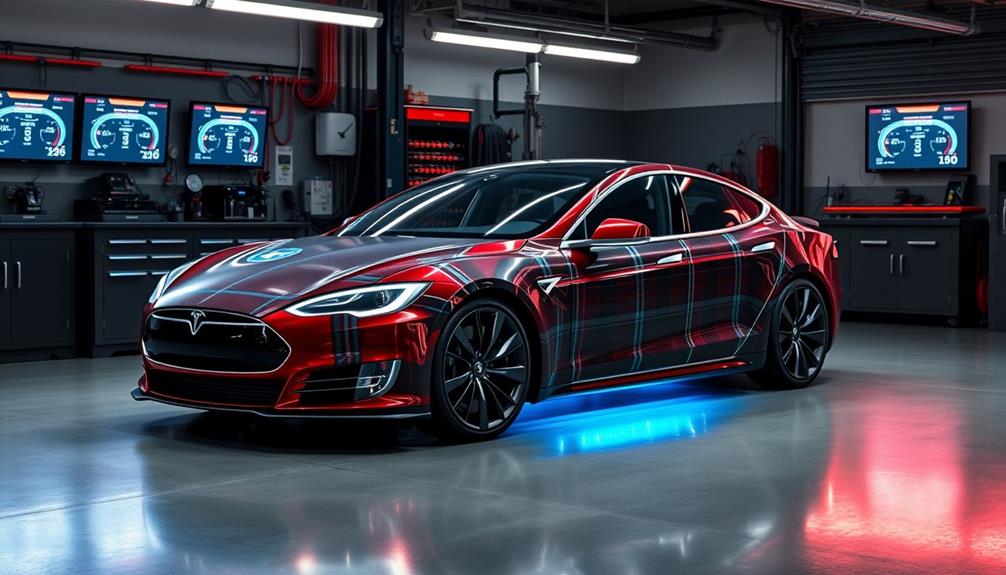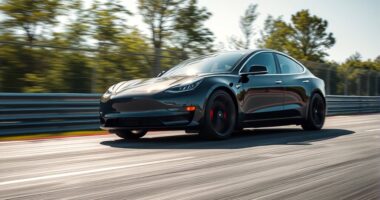To release unrivaled performance in your Tesla Plaid, focus on key tuning areas. Start by enhancing aerodynamics with high-downforce components. Optimize weight by using lightweight materials and considering interior modifications. Next, choose the right tires—like drag radials or wider options—for improved grip. Upgrade your brakes for better stopping power and efficiency. Tuning your suspension, including adjustable components, will refine handling. Finally, engage with the Tesla community for insights and shared experiences. These strategies will push your EV to new limits, and there's plenty more you can explore to maximize your Tesla's performance.
Key Takeaways
- Utilize lightweight materials and forged wheels to reduce weight and improve acceleration and handling performance in your Tesla Plaid.
- Optimize tire selection and pressure to enhance traction and grip, ensuring maximum performance during acceleration and cornering.
- Upgrade to a high-performance brake system with carbon-ceramic discs and aggressive pads for improved stopping power and reduced brake fade.
- Fine-tune suspension dynamics with coilovers and adjustable control arms to enhance cornering stability and overall handling characteristics.
- Engage with the Tesla community for insights on performance modifications, aftermarket innovations, and shared experiences to optimize your EV.
Understanding Tesla Plaid Performance
When you consider the Tesla Model S Plaid, it's hard to ignore its jaw-dropping performance. With a tri-motor powertrain delivering over 1,000 horsepower, you can achieve heart-pounding 0-60 mph times in just 1.99 seconds under ideal conditions.
But to truly harness this power, you'll want to explore the performance upgrades available, especially the Track Mode feature.
Track Mode takes your driving experience to another level, allowing you to fine-tune various aspects of the vehicle. You can individually adjust stability control, handling balance, and regenerative braking, giving you enhanced control on the racetrack.
The optimized cooling systems also play a vital role, managing battery, motor, and brake temperatures to maintain peak performance during intense driving.
Additionally, the lateral torque vectoring technology enhances your cornering capabilities, adjusting torque on the front and rear wheels for improved turn-in response.
With Track Mode, you can even control tire slippage based on your skill level and driving conditions, making it easier to adapt the Plaid's performance to your preferences.
Embracing these features will reveal the full potential of your Tesla Model S Plaid.
Essential Weight Reduction Techniques

To boost your Tesla Plaid's performance, consider lightweight materials and strategic interior modifications.
By swapping out heavy components for lighter alternatives, you can greatly improve acceleration and handling.
Lightweight Materials Utilization
In the quest for enhanced performance, lightweight materials play a pivotal role in optimizing Tesla Plaid models. By focusing on lightweight materials utilization, you can markedly improve your vehicle's dynamics and handling.
Start with lightweight forged wheels; these reduce unsprung weight, directly impacting performance.
Next, consider incorporating carbon ceramic brakes. Not only do they enhance stopping power, but they also save weight—larger discs can cut about 25 pounds compared to stock options.
If you're involved in kit cars with plaid components, you could achieve impressive weight savings of up to 1,000 pounds, showcasing just how effective weight reduction techniques can be.
You can also explore interior gutting and selectively removing heavy battery components to shave off additional weight. This directly correlates with improved acceleration times and track performance.
However, always strike a balance; excessive weight loss might compromise vehicle stability, leading to diminishing returns in performance metrics.
Interior Modifications Strategies
Interior modifications can greatly enhance the performance of your Tesla Plaid by reducing weight and improving acceleration. One of the most effective strategies is gutting the interior, which can lead to significant weight savings vital for racing scenarios.
Consider removing unnecessary components such as rear seats, sound insulation, and non-essential electronics; this can help reduce overall vehicle weight by hundreds of pounds.
To further achieve weight reduction, replace heavy stock parts with lightweight alternatives. Carbon fiber panels and racing seats not only decrease weight but also maintain the structural integrity of your vehicle.
However, it's important to balance weight reduction with vehicle stability to avoid compromising handling performance.
In well-executed scenarios, interior gutting can save approximately 1,000 pounds, translating to substantial performance gains in your Tesla Plaid.
Keep in mind that each modification should be carefully considered to guarantee you retain the driving dynamics that make the Tesla experience so exhilarating.
Optimizing Tire Selection
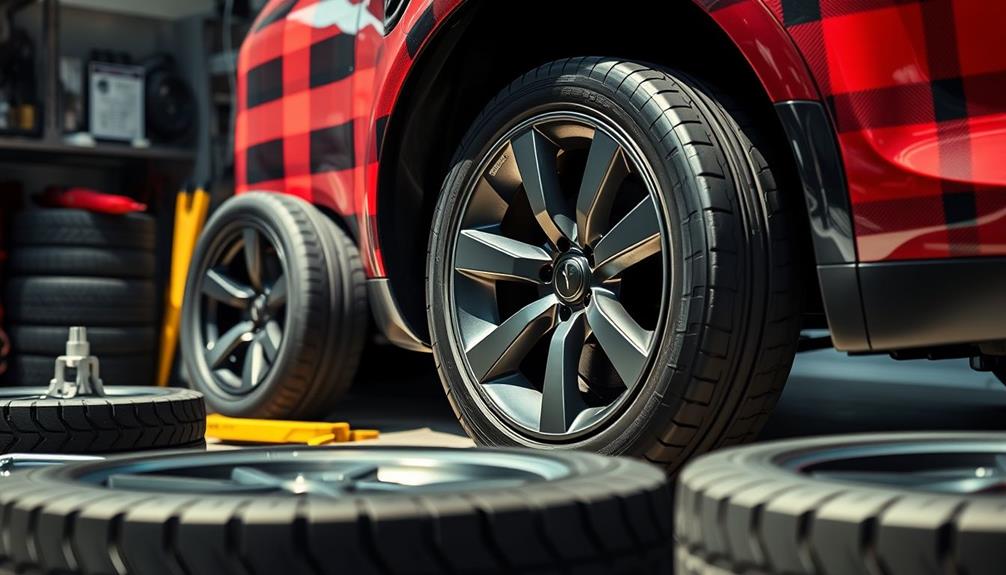
When you're tuning your Tesla Plaid, tire selection is essential for maximizing performance.
Choosing the right type, size, and pressure of your tires can dramatically enhance traction and acceleration.
Let's explore how these factors come together to optimize your ride.
Tire Type Selection
Choosing the right tires for your Tesla Plaid can make a world of difference in performance, especially if you're aiming for ideal acceleration and grip.
When it comes to tire type selection, you'll want to focus on options that enhance traction and stability. Here are three key considerations:
- Drag Radial Tires: Selecting NT555RII drag radial tires can greatly improve traction for weekend drag racing. Their D.O.T-compliant design allows for flexibility during acceleration, ensuring you get the most out of your Tesla's power.
- Tire Width: Using wider tires, like 310-section-width racing slicks or 315-width tires, enhances grip and stability, especially during high-speed cornering. Wider tires help maintain control and improve overall performance.
- Wheel Size: The choice of wheel size matters. Opting for 19-inch wheels may offer better drag radial performance compared to larger 21-inch options, particularly at higher speeds.
Sizing for Performance
Optimizing tire selection for your Tesla Plaid is vital to achieving peak performance on the track or during spirited driving.
When sizing for performance, consider the impact of wheel size on acceleration. Switching to 19-inch wheels from 21-inch ones can reduce rotational mass, enhancing speed and responsiveness. If you're looking for grip, NT555RII drag radial tires are an excellent choice, providing traction for weekend drag racing while remaining D.O.T compliant.
Wider tires, like 310-section-width racing slicks, deliver superior grip, which is essential for optimizing both acceleration and cornering capabilities. Custom wheel options, such as lightweight billet machined wheels in a 19-by-10.9-inch size, help minimize unsprung weight, improving your Tesla's overall dynamics.
Don't overlook the importance of camber adjustments when sizing for performance. By setting nearly 4 degrees of negative camber through adjustable rear camber, you can enhance tire contact with the road, greatly boosting cornering grip and stability during high-performance driving.
With these considerations in mind, you're well on your way to revealing the full potential of your Tesla Plaid.
Pressure Optimization Techniques
To get the most out of your Tesla Plaid's performance, adjusting tire pressure is essential. Proper tire pressure plays a significant role in maximizing traction, especially during acceleration.
Here are three key techniques to optimize your tire selection and pressure:
- Choose the Right Tires: Opt for NT555RII drag radial tires, which are D.O.T-compliant and designed for flexibility. They can greatly enhance traction, making them perfect for weekend drag racing.
- Adjust Tire Pressure: Lowering tire pressure can improve grip during acceleration, but be careful not to go too low. Find a balance to prevent excessive tire wear or blowouts—this is critical for maintaining performance.
- Maximize Front Tire Size: Use the largest possible front tires, like 310-section-width racing slicks, to boost grip and stability. This setup not only aids in high-speed cornering but also improves straight-line acceleration.
Advanced Brake System Upgrades
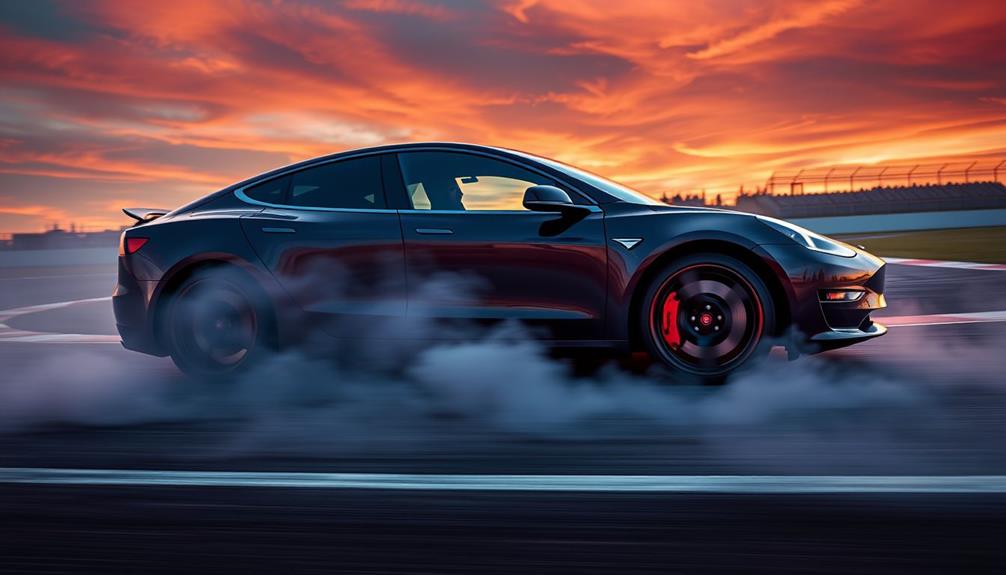
Upgrading your Tesla Plaid's brake system can greatly enhance its performance on the track. One of the most impactful advanced brake system upgrades you can make is switching to lightweight carbon-ceramic brake discs. These discs not only save up to 25 pounds of unsprung weight but also provide significant stopping power and reduce brake fade during intense driving.
To maintain ideal braking performance, especially under extreme conditions, you should utilize high-temp brake fluid and aggressive brake pads. This combination prevents brake fade and enhances responsiveness, essential for high-speed maneuvers.
Additionally, consider implementing a big brake kit (BBK) with larger rotors and custom calipers. This upgrade improves heat dissipation and overall braking efficiency, making it vital for track-focused performance.
Opting for six-piston calipers provides superior braking force and modulation, allowing your Tesla to slow down quickly and safely.
To further enhance performance, adding brake duct kits can help maintain ideal brake temperatures during racing, preventing overheating and ensuring consistent performance throughout your track events.
These advanced upgrades will transform your driving experience and maximize your Tesla Plaid's potential.
Enhancing Aerodynamics
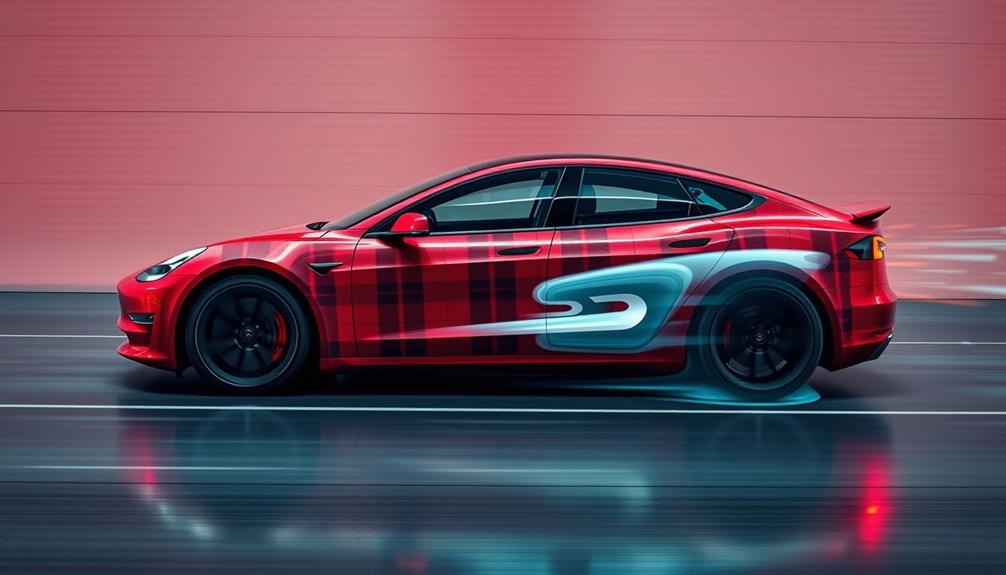
When it comes to enhancing your Tesla Plaid's performance, improving aerodynamics can make a noticeable difference. By focusing on specific upgrades, you can greatly boost your EV's stability and efficiency at high speeds.
Here are three effective ways to enhance aerodynamics:
- Upgrade to a High-Downforce Rear Wing: This addition increases downforce, improving cornering capabilities and overall stability during aggressive maneuvers.
- Reshape Factory Front Fenders: By modifying the fenders, you allow for better airflow and tire coverage. This reduction in drag enhances aerodynamic efficiency, helping your Tesla slice through the air more effectively.
- Add Air-Extraction Ducts: These ducts manage airflow more effectively, reducing lift and drag. Improved airflow management guarantees that your vehicle remains stable at high speeds, enhancing overall performance.
Balancing aerodynamics with weight management is vital for maximizing track performance.
Tuning Suspension Dynamics
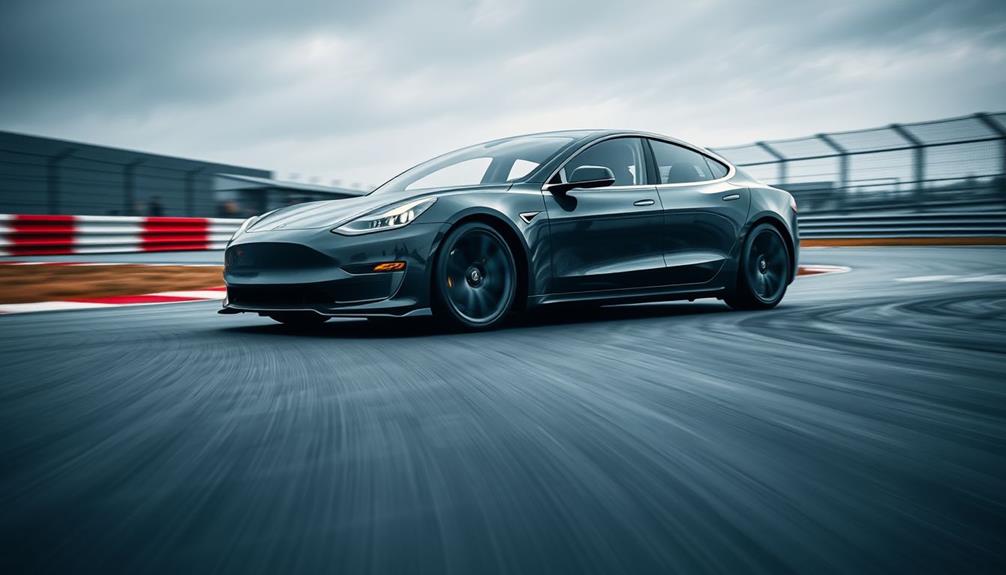
Improving your Tesla Plaid's aerodynamics sets the stage for fine-tuning its suspension dynamics, which can elevate your driving experience to the next level.
Upgrading to coilovers or lowering springs is a fantastic way to enhance handling by lowering the vehicle's center of gravity and improving cornering stability.
Consider adjustable front upper control arms, which allow you to set nearly 4 degrees of negative camber, optimizing grip during aggressive cornering.
Installing adjustable rear camber arms and toe links gives you even more tuning options, enabling precise adjustments for better tire contact with the road.
If you're serious about track driving, a quick-change front control arm system is essential. This setup lets you implement aggressive track settings without risking tire damage, enhancing performance during competitive driving.
For a thorough upgrade, the High Performance Suspension Package, priced between $7,370.00 and $7,865.00, greatly improves your vehicle's overall dynamics and responsiveness.
Engaging With the Tesla Community
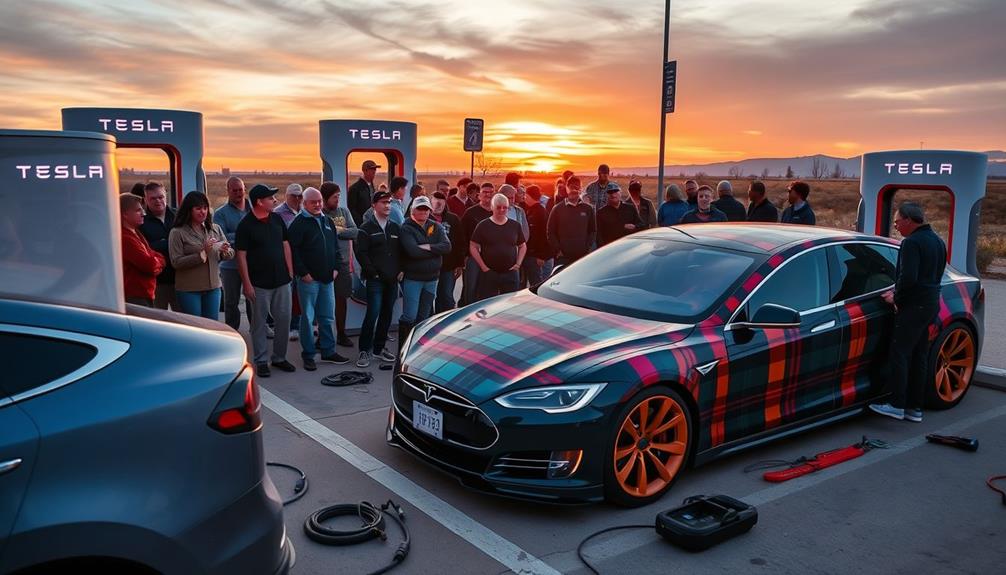
Community engagement enriches the Tesla ownership experience, offering a wealth of insights into performance modifications. By connecting with the Tesla community, you gain access to valuable knowledge that can help you optimize your vehicle. Online forums and local meetups are great platforms to share and gather tips on tuning and upgrades.
Here are three key benefits of engaging with fellow Tesla enthusiasts:
- Performance Optimization: Discover weight reduction strategies, tire choices, and suspension tuning options that enhance your vehicle's handling and speed.
- Aftermarket Innovations: Stay updated on the latest aftermarket modifications, with many community members sharing their experiences and even creating waitlists for highly sought-after upgrades.
- Collective Knowledge: Tap into a wealth of collective experiences, as discussions often revolve around street-legal performance versions optimized for racing and track use.
Your feedback is also essential, as Tesla frequently considers community input when developing software updates and performance tuning options.
Engaging with the Tesla community not only enhances your vehicle's performance but also fosters a sense of camaraderie among fellow Tesla owners.
Frequently Asked Questions
How to Unlock Tesla Plaid?
To release your Tesla Plaid's potential, engage Track Mode, consider aftermarket modifications, and invest in lightweight wheels and high-performance tires. These steps enhance acceleration, handling, and overall performance for an exhilarating driving experience.
How Do You Turn on Performance Mode on a Tesla?
Imagine your Tesla as a caffeinated cheetah, ready to sprint. To release its power, just tap the touchscreen, head to "Driving," and flip the "Acceleration" switch to "Performance." You won't regret it!
How Do You Unlock Ludicrous Mode on a Tesla?
To unfasten Ludicrous Mode on your Tesla, you'll need to purchase the Ludicrous Speed Upgrade. Once activated, enjoy mind-blowing acceleration, transforming your driving experience with remarkable speed and performance right at your fingertips.
What Is the Insane Mode on a Tesla?
Ever wondered what true speed feels like? Insane Mode on your Tesla releases thrilling acceleration, propelling you from 0-60 mph in just 2.4 seconds. Engage it via the touchscreen, but brace yourself for the ride!
Conclusion
Releasing the full potential of your Tesla Plaid isn't just a dream; it's within your grasp. By implementing weight reduction, choosing the right tires, upgrading your brakes, enhancing aerodynamics, and tuning your suspension, you're not just tuning an EV—you're transforming your driving experience. So, why settle for ordinary when extraordinary is just a few tweaks away? Immerse yourself in the Tesla community, share your journey, and watch as your Plaid evolves into a true performance beast.
